
The Teloschistaceae are a large family of mostly lichen-forming fungi belonging to the class Lecanoromycetes in the division Ascomycota. The family has a cosmopolitan distribution, although members occur predominantly in subtropical and temperate regions. Although most members are lichens that either live on rock or on bark, about 40 species are lichenicolous – meaning they are non-lichenised fungi that live on other lichens. Many members of the Teloschistaceae are readily identifiable by their vibrant orange to yellow hue, a result of their frequent anthraquinone content. The presence of these anthraquinone pigments, which confer protection from ultraviolet light, enabled this group to expand from shaded forest habitats to harsher environmental conditions of sunny and arid ecosystems during the Late Cretaceous.

Gyalolechia is a genus of lichen-forming fungi belonging to the family Teloschistaceae. It contains 18 species of crustose lichens.

Flavoplaca is a genus of crust-like or scaly lichens in the family Teloschistaceae. It has 28 species with a mostly Northern Hemisphere distribution.
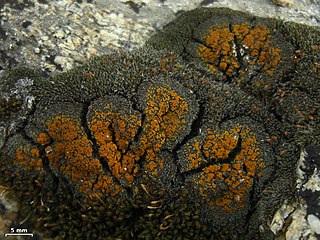
Parvoplaca is a genus of lichen-forming fungi in the family Teloschistaceae. The genus was circumscribed in 2013 by Ulrik Søchting, Patrik Frödén, and Ulf Arup.
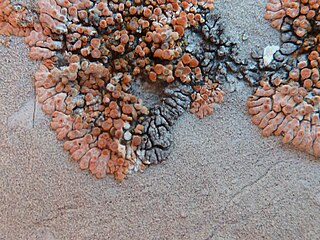
Calogaya arnoldii is a species of saxicolous (rock-dwelling), crustose lichen that is common and widespread in Europe and Asia. It is in the family Teloschistaceae. It was first formally described as a new species in 1876 by Hugh Algernon Weddell, as a species of Lecanora. After being transferred to Caloplaca in 1915, it was considered as a member of that genus for nearly a century. Molecular phylogenetic studies showed Caloplaca to be polyphyletic, and it was divided up into several smaller genera in 2013. Calogaya arnoldii was one of eight species transferred to the newly circumscribed Calogaya by Ulf Arup, Patrik Frödén, and Ulrik Søchting. The lichen is part of a species complex with complicated taxonomy, and in which intermediate phenotypes are frequently observed, making it difficult to reliably distinguish them. Calogaya saxicola is one such similar species, and it has often been confused with C, arnoldii in areas where they co-occur, as the differences between them are subtle.
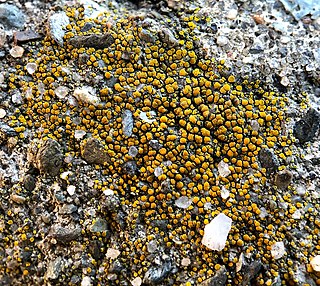
Xanthocarpia feracissima is a species of saxicolous, crustose lichen in the family Teloschistaceae. It was first formally described as a new species in 1953 by Swedish lichenologist Adolf Hugo Magnusson, as a member of the genus Caloplaca. The type specimen was collected in 1939 by John Walter Thomson in Lake Koshkonong, Wisconsin. In the original description, Magnusson notes a similarity to the lichen now known as Gyalolechia flavovirescens, but distinguishes the new species by its lack of a visible thallus, the sordid-reddish color of its discs, and the "unusually narrow" septa of the spores. Patrik Frödén, Ulf Arup, and Ulrik Søchting transferred the taxon to Xanthocarpia in 2013, following molecular phylogenetic analysis of the family Teloschistaceae.

Xanthocarpia crenulatella is a species of saxicolous (rock-dwelling), crustose lichen in the family Teloschistaceae.
Solitaria is a fungal genus in the family Teloschistaceae. It contains a single species, the corticolous (bark-dwelling), crustose lichen Solitaria chrysophthalma.
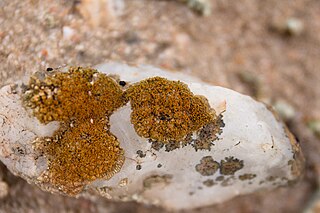
Stellarangia namibensis is a species of saxicolous (rock-dwelling), crustose lichen in the family Teloschistaceae. It was first formally described in 1988 by Ingvar Kärnefelt, as a member of the genus Caloplaca. The type specimen was collected by the author from the gravel flats east of Cape Cross, in Omaruru, Namibia. The same species was collected from Angola by Austrian botanist Friedrich Welwitsch in 1859. The taxon was transferred to the genus Stellarangia in 2013 by Ulrik Søchting and colleagues, as part of a molecular phylogenetics-based restructuring of the Teloschistaceae.
Sirenophila gintarasii is a species of lichen in the family Teloschistaceae. Found in Australia, it was formally described as a new species in 2009 by lichenologists Sergey Kondratyuk and Ingvar Kärnefelt, as a member of the genus Caloplaca. The type specimen was collected by the authors from the Camel Rock reserve. There it was found growing on coastal rock outcrops, along with the crustose species Sirenophila eos and Dufourea ligulata, some of which had been deformed by the lichenicolous fungus species Arthonia sytnikii and Pyrenidium actinellum. The species epithet honours Tasmanian lichen lichenologist Gintaras Kantvilas. Ulf Arup and colleagues transferred the taxon to the genus Sirenophila in 2013, following a molecular phylogenetics-based restructuring of the family Teloschistaceae. Sirenophila gintarasii occurs in New South Wales and Victoria.

Calogaya decipiens is a species of saxicolous (rock-dwelling), crustose lichen in the family Teloschistaceae. It was first scientifically described in 1867 by German lichenologist Ferdinand Christian Gustav Arnold, as a member of the genus Physcia. Ulf Arup and colleagues transferred the taxon to the genus Flavoplaca in 2013, following a molecular phylogenetics-based restructuring of the family Teloschistaceae.
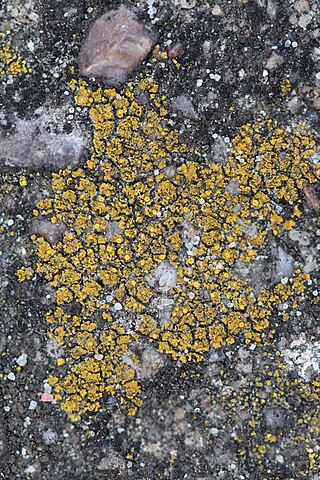
Flavoplaca arcis is a species of saxicolous (rock-dwelling), crustose to squamulose (scaley) lichen in the family Teloschistaceae. Although widely distributed in Northern, Central, and Western Europe, it is not commmonly encountered.
Sirenophila maccarthyi is a species of corticolous/lignicolous, crustose lichen in the family Teloschistaceae. It has a thallus that is whitish or greyish, often inconspicuous and not always continuous, which can appear darker or dirty grey near its numerous, clustered apothecia. Sirenophila maccarthyi is distributed across regions including Western Australia, New South Wales, Victoria, Tasmania, and New Zealand, in both coastal and inland habitats. It typically grows on the bark and dead wood of a wide range of trees and shrubs such as Acacia sophorae, Araucaria excelsa, and various Eucalyptus species.
Caloplaca sterilis is a corticolous (bark-dwelling), crustose lichen belonging to the family Teloschistaceae, described in 2011. It is primarily found in steppe and sand dune habitats in the Black Sea region, and has been recorded from Bulgaria, Romania, southwest Russia, and Ukraine. Caloplaca sterilis is characterised by tiny squamules/areoles with contrasting pale greyish-green to greenish soredia. It is easily overlooked and challenging to identify when completely sorediate and sterile, especially as its soredia do not contain the typical Sedifolia-grey pigment.

Flavoplaca austrocitrina is a species of saxicolous (rock-dwelling), crustose lichen in the family Teloschistaceae. It is widely distributed in Europe, and has also been recorded in South America.

Flavoplaca limonia is a species of saxicolous (rock-dwelling), crustose lichen in the family Teloschistaceae. It was first formally described as a new species in 1994 by lichenologists Pier Luigi Nimis and Josef Poelt. Ulf Arup and colleagues transferred the taxon to the genus Flavoplaca in 2013, following a molecular phylogenetics-based restructuring of the family Teloschistaceae.

Flavoplaca maritima is a species of crustose lichen in the family Teloschistaceae. It is found in costal areas of Northern, Western, and Southern Europe. It mostly occurs on rocks, but has also been recorded growing on wood.

Parvoplaca tiroliensis is a species of crustose lichen in the family Teloschistaceae, and the type species of the genus Parvoplaca. It is widely distributed, and has been recorded growing on a variety of substrates, including moss, dead plant material, and bone.

Polycauliona bolacina, the waxy firedot lichen, is a species of saxicolous (rock-dwelling), crustose lichen in the family Teloschistaceae. It is found in western North America.
Flavoplaca kantvilasii is a species of saxicolous (rock-dwelling), crustose lichen in the family Teloschistaceae. Found in Australia, it was formally described as a new species in 2007.













